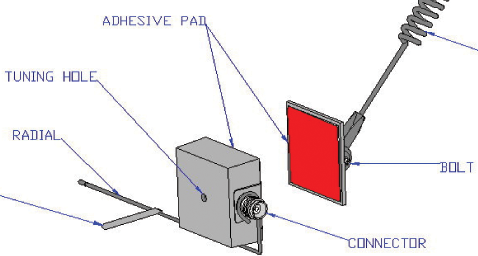First off, I have no intention of mounting this on a vehicle - my NMO works wonderfully. 
I apologize if the bold lettering offends anyone, but I really wanted to emphasize that any experimenting with this thing will be sans vehicle.
The antenna came to me in a box of odd pieces/parts that was given to me awhile ago. And since a big reason I got my ham ticket was to play and experiment, I couldn't resist pondering the potential of this little fella. No sense in letting a good piece of metal go to waste.
(On a side-note, I was eyeballing this tall, ugly lamp in the living room, but my wife suggested I might experience sudden health issues if I touched that lamp... Thus, the glass-mount antenna project was born!)
The antenna is an Opek VUG-270 ( VHF/UHF ) DUAL BAND MOBILE which is a company/brand I have never heard of. I will list the manufacturer (claims) specs at the end of this post.

I would have guessed for a radial (counterpoise?) such as this it might work better if it were inline (vertical) with the actual antenna. (Apparently I still have much to learn.)
In any case, this isn't for primary comms or even an emergency - those are well covered. This is just me wanting to try out my first non-traditional antenna experiment with a somewhat ready-made piece of material. It didn't cost me any extra to acquire it and won't be a huge loss if it turns out to be useless. But it's already here and serving no other purpose, and I'm pretty sure (see REALLY HOPE) I won't need a fire extinguisher if this experiment flops. :lol: So, why not?
Any help, advice, even your experience with similar projects, is welcome and appreciated. Thanks much and 73's!
-
Manufacturer (Claims) Specifications:
I apologize if the bold lettering offends anyone, but I really wanted to emphasize that any experimenting with this thing will be sans vehicle.
The antenna came to me in a box of odd pieces/parts that was given to me awhile ago. And since a big reason I got my ham ticket was to play and experiment, I couldn't resist pondering the potential of this little fella. No sense in letting a good piece of metal go to waste.
(On a side-note, I was eyeballing this tall, ugly lamp in the living room, but my wife suggested I might experience sudden health issues if I touched that lamp... Thus, the glass-mount antenna project was born!)
The antenna is an Opek VUG-270 ( VHF/UHF ) DUAL BAND MOBILE which is a company/brand I have never heard of. I will list the manufacturer (claims) specs at the end of this post.
- My first question is, can this be used without glass (or some other faux capacitor) placed between the contacts? Can I just go ahead and place the two contacts together without causing a safety issue?
- Second question, why is the included radial (on the inside connector) at a horizontal angle?

I would have guessed for a radial (counterpoise?) such as this it might work better if it were inline (vertical) with the actual antenna. (Apparently I still have much to learn.)
- Third question, if I can simply connect the contacts and get to safely experimenting, should I rely on the "built-in" tuning apparatus that it claims to have or should I look at getting a manual tuner for SWR?
I've edited this post to add a fourth question...
- Question four, is the length of the antenna based upon the coiling in the center?
In any case, this isn't for primary comms or even an emergency - those are well covered. This is just me wanting to try out my first non-traditional antenna experiment with a somewhat ready-made piece of material. It didn't cost me any extra to acquire it and won't be a huge loss if it turns out to be useless. But it's already here and serving no other purpose, and I'm pretty sure (see REALLY HOPE) I won't need a fire extinguisher if this experiment flops. :lol: So, why not?
Any help, advice, even your experience with similar projects, is welcome and appreciated. Thanks much and 73's!
-
Manufacturer (Claims) Specifications:
- GLASS MOUNT MOBILE ANTENNA 2 METER AND 70 CM
- FREQUENCY: 144-148 MHz / 440-450 MHz
- GAIN: 2. dB Over 1/4 Wave (2 m) and 4 dB Over 1/4 Wave (70 cm)
- V.S.W.R: Less than 1.5:1 Through Bands
- POWER: 50 W (max)
- FIELD TUNABLE
- CABLE: 14′ of RG-58 Cable
- CONNECTION: With PL-259
- 26″ STAINLESS STEEL Whip, With Black Finish.
- LENGTH: 28.35″ ( 720 mm )
Last edited:

